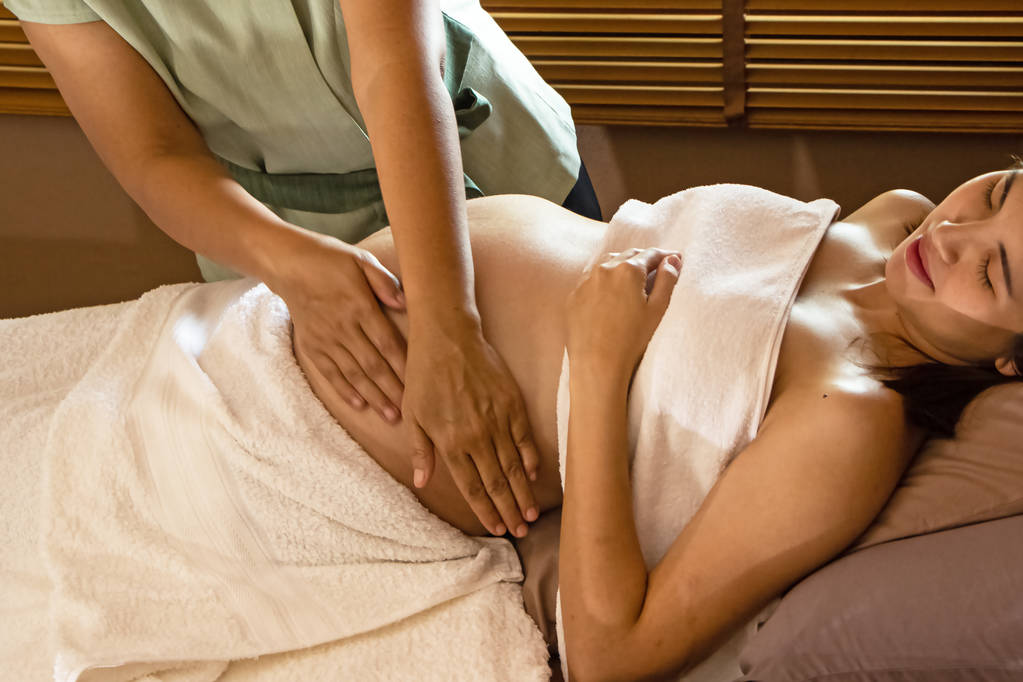Discover if certain women are more susceptible to experiencing back pain related to the hormone relaxin.
Are Certain Women More Prone to Relaxin-Related Back Pain?
If you’ve ever experienced back pain, you know how debilitating it can be. But did you know that certain women may be more prone to a specific type of back pain called relaxin-related back pain? In this article, we’ll explore the fascinating connection between relaxin and back pain, uncover the factors that influence relaxin levels in women, learn how to identify relaxin-related back pain, and discover the various treatment options available. So grab a cup of tea, get comfortable, and let’s dive in!

Understanding Relaxin and Its Role in the Body
Before we delve into the world of relaxin-related back pain, let’s first understand what relaxin actually is. Relaxin is a hormone produced by the ovaries and placenta in women. Its role is to loosen the ligaments and connective tissues in the body, particularly in the pelvic region, in preparation for childbirth. Think of it as nature’s way of making the birthing process a little bit easier.
But relaxin’s effects extend beyond just the pelvic region. When relaxin is released into the bloodstream, it travels to its target sites throughout the body and binds to receptors on the ligaments and connective tissues. This binding process causes these tissues to become more elastic and flexible, allowing for easier movement and stretching during pregnancy.
During pregnancy, relaxin levels increase significantly, reaching their peak in the first trimester. This surge in relaxin production is necessary to prepare the body for the physical changes that occur during pregnancy. It helps to widen the pelvis, allowing for the baby to pass through the birth canal more easily. Additionally, relaxin also affects other joints in the body, including the back.
So, how does relaxin impact the back? Well, the ligaments and connective tissues in the back also become more elastic and flexible due to the effects of relaxin. This increased flexibility can lead to changes in the alignment and stability of the spine, which may result in back pain or discomfort for some pregnant women.
It’s important to note that not all women experience relaxin-related back pain during pregnancy. The severity and frequency of back pain can vary from person to person. Factors such as pre-existing back conditions, posture, and physical activity levels can also influence the likelihood of experiencing back pain.
While relaxin-related back pain is a common occurrence during pregnancy, there are ways to manage and alleviate the discomfort. Maintaining good posture, engaging in regular exercise, and practicing relaxation techniques can help reduce the strain on the back and provide relief. Additionally, using supportive pillows or cushions while sitting or sleeping can help provide extra support to the back.
It’s important for pregnant women to listen to their bodies and seek medical advice if they experience severe or persistent back pain. A healthcare provider can provide personalized recommendations and guidance to address any concerns or discomfort during pregnancy.
The Connection Between Relaxin and Back Pain
Now that we have a grasp of what relaxin is and how it functions, let’s explore the link between relaxin and back pain. The biological mechanisms linking relaxin to back pain are still being studied, but researchers have discovered some intriguing findings.
One factor that plays a role in relaxin-related back pain is the impact of relaxin on women’s spinal health. As relaxin loosens the ligaments and connective tissues in the pelvic region, it can also affect the stability of the spine. This can lead to increased strain on the back muscles and joints, potentially resulting in back pain.
Furthermore, studies have shown that relaxin levels tend to increase during pregnancy. This is because relaxin plays a crucial role in preparing the body for childbirth by softening the ligaments in the pelvic area. However, the increased levels of relaxin can also have an impact on the back. As the ligaments in the pelvic region become more relaxed, the stability of the spine may be compromised, leading to an increased risk of back pain.
In addition to pregnancy, relaxin levels can also fluctuate during the menstrual cycle. Research has suggested that relaxin may be involved in the regulation of pain perception, and its levels may rise during certain phases of the menstrual cycle. This could potentially contribute to the development of back pain in some women during their menstrual periods.
Moreover, relaxin is not only produced in women but also in men, although at lower levels. In men, relaxin has been found to play a role in the regulation of blood pressure and cardiovascular health. However, it is still unclear whether relaxin levels in men have any direct impact on back pain.
It is worth noting that while relaxin has been implicated in the development of back pain, it is not the sole factor. Other factors such as poor posture, sedentary lifestyle, muscle imbalances, and injury can also contribute to the occurrence of back pain. Therefore, it is important to consider relaxin as one piece of the puzzle when exploring the causes of back pain, rather than the sole culprit.
Factors Influencing Relaxin Levels in Women
Now that we understand the connection between relaxin and back pain, let’s explore the factors that influence relaxin levels in women. Age and pregnancy have been identified as two key factors.
Age and Relaxin Production
As women age, their production of relaxin decreases. This means that older women may have lower levels of relaxin in their bodies, making them less prone to relaxin-related back pain. So, ladies, there may be an upside to getting older after all!
Age-related changes in relaxin production can be attributed to various factors. One such factor is the decline in ovarian function that occurs with age. The ovaries play a crucial role in the production of relaxin, and as they age, their ability to produce this hormone diminishes. Additionally, the overall hormonal balance in the body shifts as women grow older, leading to a decrease in relaxin levels.
It is important to note that the decline in relaxin production with age does not occur uniformly in all women. Individual variations in genetics, lifestyle, and overall health can influence how quickly or slowly relaxin levels decrease. Factors such as regular exercise, a healthy diet, and stress management techniques have been found to positively impact relaxin production and may help maintain optimal levels even as women age.
Pregnancy and Relaxin Levels
Pregnancy is a time when relaxin levels skyrocket. As the body prepares for childbirth, relaxin production increases significantly. This surge in relaxin can lead to more significant changes in the ligaments and connective tissues, making pregnant women more susceptible to relaxin-related back pain.
The increase in relaxin during pregnancy is a natural and necessary process. It helps to loosen the ligaments in the pelvic area, allowing for easier passage of the baby through the birth canal. However, the effects of relaxin are not limited to the pelvic region alone. The hormone affects the entire musculoskeletal system, including the spine.
During pregnancy, relaxin levels rise steadily, reaching their peak in the third trimester. This increase in relaxin can cause the ligaments supporting the spine to become more lax, leading to instability and potential discomfort. The additional weight gain during pregnancy also puts extra strain on the back, exacerbating the effects of relaxin-related changes.
It is worth noting that relaxin levels vary among pregnant women. Factors such as the number of previous pregnancies, the individual’s hormonal profile, and overall health can influence the amount of relaxin produced. Additionally, relaxin levels tend to return to normal within a few months after childbirth, as the body no longer needs the hormone to support pregnancy.
In conclusion, age and pregnancy play significant roles in influencing relaxin levels in women. Understanding these factors can help healthcare professionals develop targeted interventions to manage relaxin-related back pain and improve the overall well-being of women at different stages of life.
Identifying Relaxin-Related Back Pain
Now that we know how relaxin and back pain are connected, let’s learn how to identify relaxin-related back pain. While every woman’s experience may be different, there are some common symptoms to watch out for.
During pregnancy, relaxin is a hormone that is released to help loosen the ligaments in the pelvic area in preparation for childbirth. However, this hormone can also affect other parts of the body, including the lower back. As a result, some women may experience relaxin-related back pain.
Women who experience relaxin-related back pain may notice a dull, achy pain in their lower back. This pain can vary in intensity and may be intermittent or constant. It may also worsen with certain movements or activities, such as standing for long periods, walking, or lifting heavy objects.
In addition to the lower back pain, some women may also experience sciatica-like symptoms. This can include numbness or tingling that radiates down the leg. This sensation can be uncomfortable and may make it difficult to perform daily activities.
Diagnostic Methods for Relaxin-Related Back Pain
If you suspect you may be experiencing relaxin-related back pain, it’s essential to consult with a healthcare professional for a proper diagnosis. They have the knowledge and expertise to evaluate your symptoms and determine the underlying cause of your back pain.
During a medical evaluation, your healthcare professional may perform a physical examination to assess your range of motion, muscle strength, and any areas of tenderness. They will also review your medical history to identify any previous injuries or conditions that may contribute to your back pain.
In some cases, your healthcare professional may order imaging tests, such as X-rays or MRI scans, to get a closer look at the structures of your spine. These tests can help identify any underlying issues, such as herniated discs or spinal abnormalities, that may be causing or contributing to your back pain.
It’s important to remember that relaxin-related back pain is a common occurrence during pregnancy and usually resolves on its own after childbirth. However, if your back pain is severe, persistent, or accompanied by other concerning symptoms, it’s crucial to seek medical attention promptly.
Treatment and Management of Relaxin-Related Back Pain
So, what can be done to alleviate the discomfort caused by relaxin-related back pain? Luckily, there are several treatment options available.

Non-Surgical Treatment Options
Non-surgical treatment options for relaxin-related back pain include physical therapy, chiropractic care, and pain management techniques. Physical therapy can help strengthen the back muscles and improve posture, while chiropractic care focuses on realigning the spine to reduce pain. Pain management techniques, such as heat or cold therapy and over-the-counter pain medications, can provide temporary relief.
Surgical Interventions for Severe Cases
In more severe cases of relaxin-related back pain, surgical interventions may be necessary. These may include procedures such as spinal fusion or disc replacement, aimed at stabilizing the spine and reducing pain. Surgical interventions are typically a last resort and are only recommended when conservative treatments have failed.
So, if you’re one of those women who experience relaxin-related back pain, take comfort in knowing that there are strategies to manage and alleviate your symptoms. Remember to consult with a healthcare professional to find the best treatment plan for you. And always listen to your body – if something doesn’t feel right, don’t hesitate to seek help. Here’s to a pain-free back and a more comfortable life!



